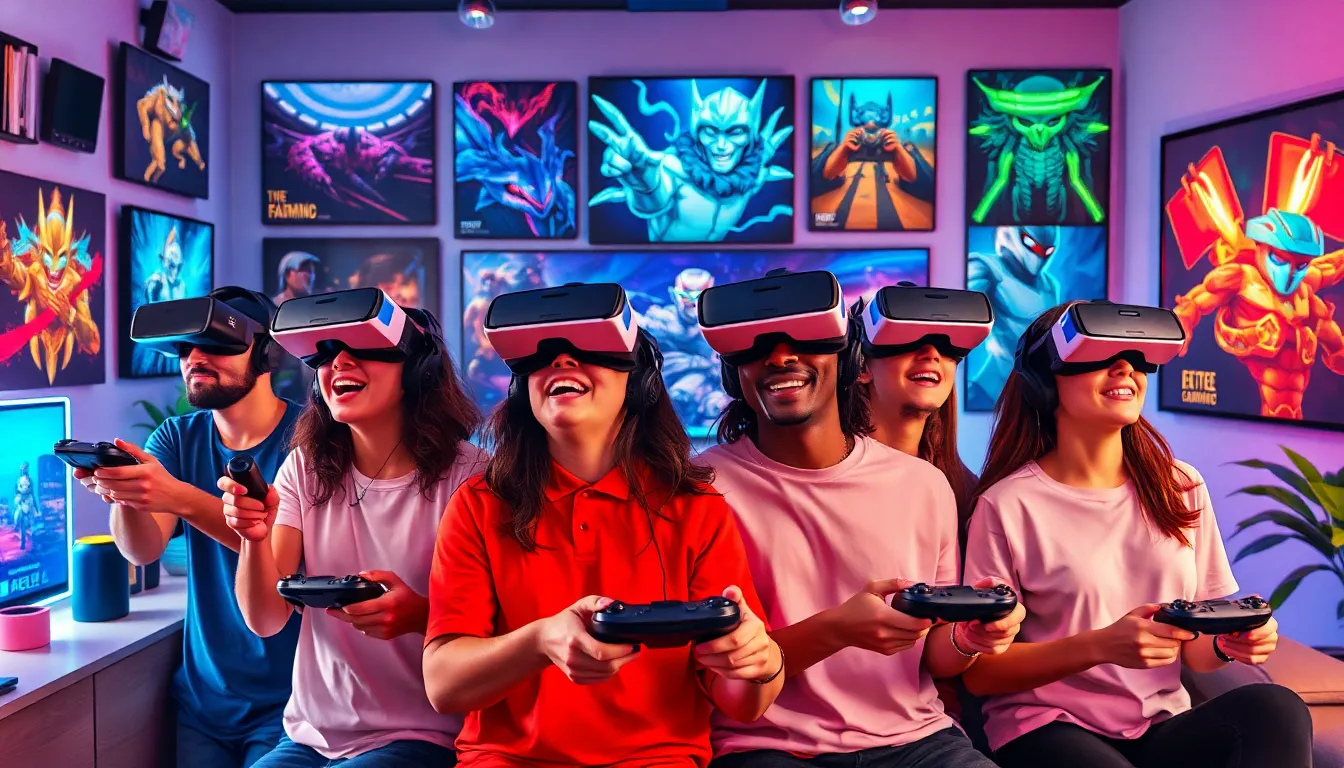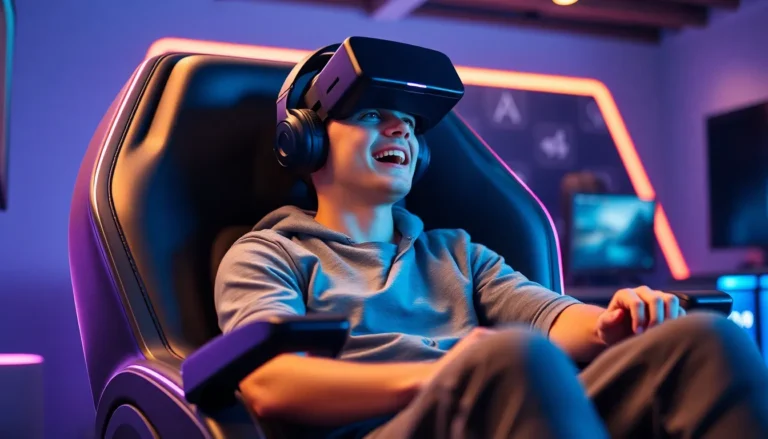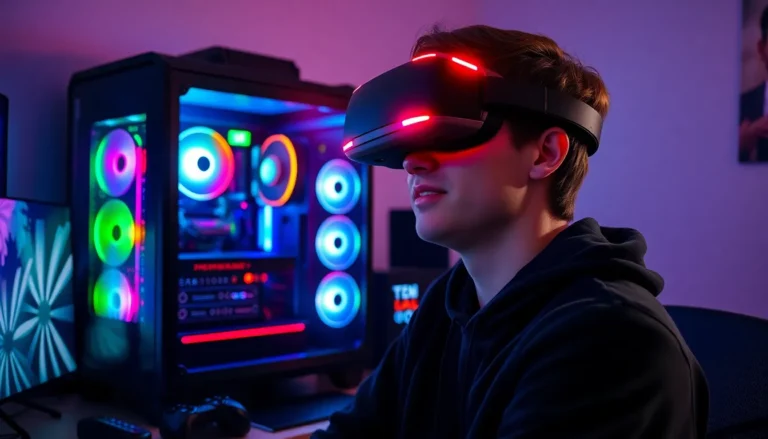In a world where reality sometimes feels a bit too mundane, gaming AR and VR swoop in like superheroes ready to rescue players from boredom. Imagine stepping into a universe where dragons roam and your living room transforms into an epic battlefield. With augmented and virtual reality, gaming has evolved from a simple pastime to an exhilarating adventure that blurs the lines between the real and the unreal.
Gaming AR VR
Gaming has evolved through the integration of augmented reality (AR) and virtual reality (VR). Both technologies enhance player interaction by creating immersive environments. AR overlays digital elements onto the real world, allowing players to interact with virtual items while in their physical surroundings. Popular AR games like Pokémon Go illustrate how seamlessly these elements blend into daily life, engaging users with navigation and exploration.
VR, on the other hand, transports players to entirely different worlds. Systems like Oculus Rift and HTC Vive provide deep immersion through visual and auditory stimulation. Gamers can explore vast landscapes, engage in intense battles, and solve intricate puzzles as if they exist within the game itself.
Statistics show that the AR and VR gaming market is anticipated to grow significantly. By 2024, it may reach a valuation of approximately $300 billion, driven by advancements in technology and increased consumer interest. This growth indicates a shift in how games are designed and played.
Numerous genres benefit from AR and VR innovations. Racing games create realistic driving scenarios, while adventure titles offer unique narratives experienced first-hand. Multiplayer interactions thrive as players connect in shared virtual spaces, enhancing social gaming experiences.
Developers continue to explore potential applications for AR and VR beyond entertainment. Education, training simulations, and therapeutic settings present new opportunities to utilize these technologies effectively. As the gaming landscape expands, the fusion of AR and VR stands at the forefront, reshaping interactions and setting new standards for reality-based entertainment.
Benefits of Gaming AR VR

Gaming with AR and VR technologies introduces several key advantages that enhance overall player experiences. These advancements make gaming more engaging and interactive.
Enhanced Immersion
Immersion reaches new heights with AR and VR. Players find themselves fully enveloped in virtual worlds or augmented zones, where every detail captivates attention. Sensory stimulation proves vital; sights, sounds, and even haptic feedback create a lifelike experience. Immersive environments promote deeper connections to gameplay, allowing players to feel as if they belong in these alternate realities. This heightened sense of presence dramatically enhances enjoyment and engagement. Popular titles leverage these immersive attributes, captivating millions and attracting new audiences. Technological progression continues to refine realism, making virtual experiences almost indistinguishable from reality.
Social Interaction
Social dynamics transform with the integration of AR and VR in gaming. Players connect meaningfully through shared experiences in virtual spaces, breaking geographical barriers. Collaboration and competition occur in real-time, enriching cooperative gameplay. Players can communicate via avatars, fostering relationships and friendships that extend beyond the screen. Unique social features encourage teamwork by requiring collective problem-solving and strategy. Games designed for multiplayer settings harness the potential of community interaction. The sense of camaraderie increases player retention and satisfaction, making online gaming more appealing. Engaging socially in these immersive environments reflects the growing trend toward interactive gaming communities.
Popular Gaming AR VR Platforms
Numerous platforms dominate the AR and VR gaming landscape, delivering unique experiences to players. Each platform offers distinct features that cater to varying preferences in gaming.
PlayStation VR
PlayStation VR stands as a crucial player in the VR gaming market. Released in October 2016, it integrates seamlessly with PlayStation 4 consoles. Users enjoy immersive experiences in titles like “Astro Bot Rescue Mission” and “Blood & Truth.” The headset features an OLED display with 1920 x 1080 resolution, delivering vibrant visuals and low latency. Developers actively support the platform, ensuring a growing library of games. Over 5 million units sold reflect its popularity, making it an essential choice for console gamers seeking VR adventures.
Oculus Quest
Oculus Quest revolutionizes the VR experience with its standalone design. Launched in May 2019, it doesn’t require a PC, making it accessible to many. Users engage with titles like “Beat Saber” and “The Walking Dead: Saints & Sinners” through its intuitive controls. Featuring a resolution of 1440 x 1600 per eye, it provides high-definition graphics. Its built-in tracking technology eliminates the need for external sensors. With over 10 million units sold, the Oculus Quest’s success highlights the increasing demand for versatile VR platforms that prioritize user-friendly experiences.
Trends in Gaming AR VR
Gaming experiences continue to evolve with the integration of AR and VR technologies. These innovations shape how players interact within digital landscapes, enhancing the overall gaming experience.
Cross-Platform Compatibility
Cross-platform compatibility significantly affects the AR and VR gaming landscape. Developers prioritize enabling players to enjoy games across various devices, including consoles, PCs, and smartphones. By breaking down barriers between platforms, gamers can connect regardless of their device. Popular titles increasingly support this feature, allowing friends to team up or compete seamlessly. Enhanced compatibility fosters a larger gaming community, and it encourages greater engagement in immersive experiences.
Cloud Gaming Integration
Cloud gaming integration is transforming how players access AR and VR content. This technology eliminates the need for powerful hardware, letting users stream games directly to their devices. A more extensive library of titles becomes available, catering to diverse gaming preferences. Providers like Google Stadia and NVIDIA GeForce Now lead this shift, offering high-quality gaming experiences without the constraints of traditional setups. Expect continued growth in cloud gaming as AR and VR technologies mature, paving the way for more engaging and accessible gaming interactions.
Challenges in Gaming AR VR
Various challenges accompany the integration of AR and VR in gaming. Key areas of concern include hardware limitations and user experience issues that developers must navigate to enhance gameplay.
Hardware Limitations
Hardware limitations present significant obstacles in the AR and VR gaming landscape. Devices often require high-performance specifications to deliver immersive experiences. Current VR headsets, like the Oculus Quest and PlayStation VR, might not offer consistent experiences across all users due to variations in processing power and graphics capabilities. Additionally, the need for external sensors or cameras can restrict player movement, breaking immersion. These challenges hinder broader adoption and limit gaming experiences, despite technological progress.
User Experience Concerns
User experience concerns arise frequently in AR and VR gaming. Players may face discomfort or motion sickness, especially during extended sessions. Such effects can detract from immersion, leading to negative associations with gaming experiences. Furthermore, complicated interfaces can overwhelm new users, making it challenging for them to engage fully with these advanced technologies. Developers must prioritize user-friendly designs and comfort solutions to ensure that AR and VR experiences appeal to a wide audience. Enhanced focus on accessibility can improve participation and enjoyment within the gaming community.
Future of Gaming AR VR
The future of gaming AR and VR presents exciting possibilities that extend beyond current innovations. Projections indicate a substantial market growth, with estimates suggesting a valuation near $300 billion by 2024. Such growth stems from heightened consumer interest and rapid technological advancements.
Emerging platforms introduce unique experiences, benefiting various genres. Racing games simulate realistic driving scenarios, while adventure titles create compelling narratives. Both genres illustrate how immersive design captivates players and deepens engagement.
Developers focus on cross-platform compatibility, allowing diverse device owners to participate in the same gaming environment. This trend fosters a vibrant community where players connect across multiple systems, increasing overall engagement.
Integrating cloud gaming transforms access to AR and VR content. Services from providers like Google Stadia and NVIDIA GeForce Now stream high-quality experiences directly to users, eliminating hardware limitations. Such accessibility expands game libraries and encourages broader participation.
Addressing challenges enhances future experiences. Hardware limitations often hinder smooth gameplay, as processing power varies among devices. User experience concerns, including potential discomfort and motion sickness, also impact engagement levels. Prioritizing user-friendly interfaces ensures that newcomers can easily enjoy immersive worlds.
Sector stakeholders strive to create innovative solutions that overcome these obstacles. Continuous research into sensory enhancements and improved design focuses on refining immersion. They envision a future where gaming AR and VR seamlessly blend with player expectations, providing unforgettable experiences in both entertainment and everyday interactions.
Conclusion
The evolution of gaming through AR and VR technologies marks a significant shift in how players engage with their favorite titles. As these immersive experiences continue to develop, they offer not just entertainment but a new way to connect with others in virtual spaces.
With the gaming market poised for substantial growth, the future looks promising for AR and VR innovations. Developers are increasingly focused on addressing challenges to ensure accessibility and comfort for all users.
As these technologies mature, they’re set to redefine the gaming landscape, creating unforgettable adventures that blur the lines between reality and imagination.





